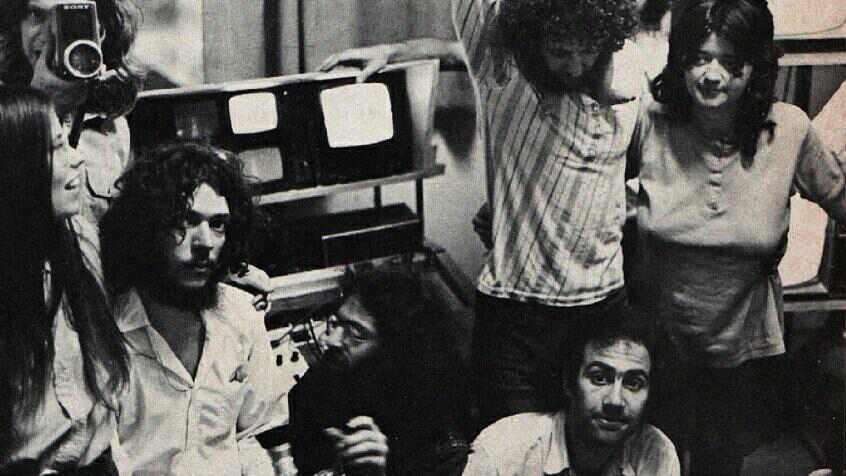Doc Corner: 'Videofreex' a New Angle on Old News
 Tuesday, March 15, 2016 at 10:30AM
Tuesday, March 15, 2016 at 10:30AM Glenn here and welcome back to Doc Corner. Each Tuesday we're bringing reviews and features on documentaries from theatres, festivals, and on demand.
 The news is constantly changing, and never more so than in today’s evolving media landscape. Where once a story would unfold nightly on the broadcast network’s news programs, now it unfolds live and often unedited, captured by anybody, anywhere. Here Come the Videofreex is a new documentary by Jenny Raskin and Jon Nealon that examines the very beginnings of this shift in news reportage by going all the way back to the late 1960s and getting up close to the then breaking trend of grass roots video journalism that was birthed in the shadow of Sony’s first video recorder units. Focusing on the collective known as the “Videofreex”, this entertaining film charts how these documentarians – and that’s exactly what they were – captured daily life, beginning with the simple act of taking a personal video camera to Woodstock and in their first act of directorial voice ignored the music entirely and instead focused on the patrons.
The news is constantly changing, and never more so than in today’s evolving media landscape. Where once a story would unfold nightly on the broadcast network’s news programs, now it unfolds live and often unedited, captured by anybody, anywhere. Here Come the Videofreex is a new documentary by Jenny Raskin and Jon Nealon that examines the very beginnings of this shift in news reportage by going all the way back to the late 1960s and getting up close to the then breaking trend of grass roots video journalism that was birthed in the shadow of Sony’s first video recorder units. Focusing on the collective known as the “Videofreex”, this entertaining film charts how these documentarians – and that’s exactly what they were – captured daily life, beginning with the simple act of taking a personal video camera to Woodstock and in their first act of directorial voice ignored the music entirely and instead focused on the patrons.
Forged by a meeting of like-minded individuals with a passion in sharing their world experiences, the team quickly graduated to CBS news employees, but that was short-lived after an attempt at a television pilot was mooted and everyone was fired. More...
That initial flirtation with professional news production saw them documenting the underground movement and included interviews with Youth International Party co-founder Abbie Hoffman as well as, most extraordinary, the Black Panthers’ Fred Hampton just weeks before he was shot and killed by police during a raid on his Chicago home. Thankfully the group of intrepid and enthusiastic reporters snuck into the CBS offices, footage of which is seen here and which is delightful, and so blessedly the footage has survived.
They continued reporting on the scene throughout many of the nation’s most important scenes including women’s liberation including the burgeoning pro-choice movement, plus Yale and May Day protests, screening their footage to dedicated crowds in their Soho loft. Before long they seized upon improved New York state arts funding and moving upstate to Lanesville where they began a local pirate television news network with the help of a transmitter donated to them by Hoffman, itself an advance version of the framework that would become reality TV.
It’s all fascinating stuff. The footage found within, restored although still bearing the hallmarks of their analogue origins, is incredible and includes on-the-ground coverage from protests, marches, and riots that is equally thrilling, shocking, and powerful. The Videofreex were doing things with news reporting that almost nobody else was at the time, certainly nobody in network news, but which over the following 47 years has become common place by professional and amateur reporters alike thanks to digital cameras and iPhones. Recent Oscar-nominated documentaries like The Square and Winter on Fire: Ukraine’s Fight for Freedom are just two recent examples that mimic the style of the Videofreex by capturing violence as it happens in the thick of the action.
Superbly edited by Nealon, its brisk 79-minute runtime is predominantly filled with this extensively curated archival footage. Do I wish they had done away with the on-screen talking head interviews? Sure, or at least maybe filmed them on video and integrated them in a more seamless manner. Would it have been good to have seen just a little bit of time allotted to look at the influence of the Videofreex? Sure, especially since one subject mentions how they were at least two decades ahead of their time. Thankfully, however, much like the photography if Vivian Maier that was gifted in the doc Finding Vivian Maier, the Videofreex’s video footage has now been rediscovered and found a larger canvas with which to be seen. Hopefully people seek Here Come the Videofreex out and learn, like I did, a little bit more about such a vital part of our filmed history that is every bit as vital. And if it helps put a spotlight on the issues surrounding the preservation of video technology – often left in the dust by the fight to save celluloid – then even better.
Release: Currently screening at IFC in New York with other screenings across the country through March and April.
Oscar Prospects: Unlikely, although it ought to at least be in the conversation.
 Doc Corner,
Doc Corner,  Reviews,
Reviews,  documentaries,
documentaries,  vhs
vhs 



Reader Comments